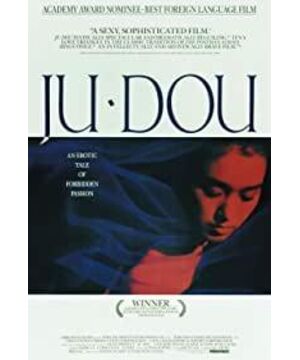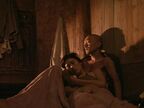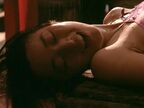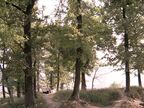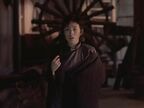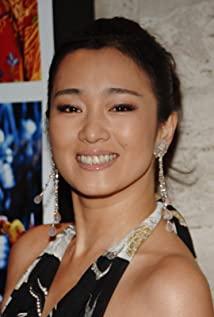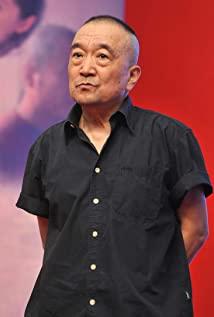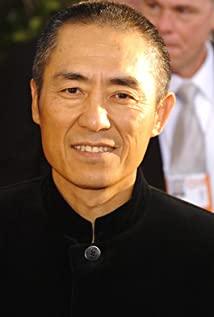A picture described transition relation Judou Azure
(a), and Azure Judou alternate one felt, red and yellow compatibility
Azure red dye was poured into the yellow dye bath was stirred, gradually spread in yellow in red, Give the viewer a strong visual stimulation. Red, like blood. Yellow, light and ambiguous. The colors at the moment are suggesting that the plot is about to move towards resistance and incest. Previously, azure and chrysanthemum beans were both yellow tones, but the combination of red and yellow at this moment indicates that the distance between azure and chrysanthemum is closer. It was Azure that added the red inducement to the chrysanthemum bean which is in the "light yellow endurance period". In the composition, the red and yellow gradually dissolve in the whole picture, and the dazzling bright red gradually disperses, implying that the resistance will continue, and it is based on the combination of them. In the plot, it corresponds to Judou's knowledge that Tianqing is not Jinshan's nephew, and it implies the development of the plot later, which is the so-called link between the past and the next.
(2) Judou's position changes, physically seduced, and the yellow
Judou walks towards another self in a bright yellow tone. The morning after Azure Knife cut the stairs, Ju Dou went to the stables to plug the hole that peeked at her and opened it. When she went out, the bright bright colors were in the sun, and her shadow hit the yellow dyed cloth, and she gradually walked towards the shadow. This picture is seductive in terms of color, and in terms of composition, Judou moves toward the shadow, which is a metaphor for walking toward another self. This picture makes people feel the direction Judou will take measures in the future.
(3). Emotionally drawn, Qing and Hong
Judou crying for help from Tianqing, she put down the red cloth in her hand and grabbed the red cloth that Tianqing threw down. This shot, color and composition together express the secret transformation of the relationship between Judou and Azure. Azure is on the roof and Judou is on the ground. Tianqing has more reason to endure than Judou, because he is nurtured by others. Moreover, he is a man, and he has a tendency to uphold the patriarchal system. No matter how much you are a cow or a horse, you can still look down on the other half of the world, a woman. Therefore, Tianqing has a higher position than Judou under the strict house of the patriarchal system. Ju Dou is asking Tianqing for help. At this moment, Ju Dou was dressed in Qingyi, she was already swallowing her breath, frivolous and charming yellow, she caught the red hanging from it. It also said that it was Azure that gave him the opportunity to resist. The following two-person combination illustrates this point. The color at this moment is exactly the development of the red and yellow compatibility when azure stirs the dye.
(Iii), to illicit sexual relations, blood-red
azure and Ju Dou first Kazushi, bright red cloth rolling down represent two Mermaid sexual relationships on the action. In terms of color, the color is thicker and purer after the red and yellow are dissolved and the red and blue are combined. It marks the formal alliance between the two. But this and the picture has a deeper meaning, because the picture is similar to this when Tianqing is beaten by his son Tianbai stick and drowned in the blood-red dyeing pond. Tian Qing could have saved himself at that time. He was murdered by Tian Bai, and the rustling red cloth layered on the surface of the dyeing pond, covering the azure. Tian Bai is the heir to this house, and at the same time inherits all the secular prejudices and rules, and the strict patriarchal consciousness. Tian Bai completely denied the combination of Judou and Tian Qing and his own life experience. He inherited the rules of his ancestors for almost no reason, and held an attitude of hatred towards Tian Qing since he was a child. Therefore, he murdered Azure, making the film more critical. Therefore, this picture is a symbol of the union of men and women as well as the looseness of blood. Blood is the foundation of life, and Azure's life has taken a turning point. With aura is this picture. It is the same scene of being submerged in the dyeing pond when being killed.
2. Assist in narrating the psychology of the characters
(1), the psychology of
Tianqing and Judou 's desire towards When Tianqing and Judou had a meal on the roof for the first time. The two are at one end, both with dyed cloth as the background. The background of chrysanthemum is more red and less cyan. Azure has more cyan and less red. The faint green is still a faint rule of suppressing desire, and the red is aggressive and rebellious. The difference in color coincides with the plot Judou's greater resistance than Azure. In the composition, Tianqing is carrying Judou on her side, but Judou turns her head to face Tianqing. The leaning side of the two poses is showing the two people's mentality of advancing and retreating toward desire.
(2) Azure’s depressive love for
Judou When Azure was ordered by Jinshan to go upstairs and ask her aunt to come down to work, the color contrasted with Azure’s mood. When he went upstairs, it was warm earth red, and it seemed that a flame was about to emerge. It is in line with Tian Qing's inner desire and love for Judou. When Azure talked to Judou, a bunch of red peppers were on the left side. Although the peppers are a manifestation of life, they are present with the embarrassing image of Azure at this moment, and they express the mental state of Azure. Both color and composition serve the plot.
(3) Jinshan's desire for children
The red lanterns bought by Jinshan for the New Year are written "full of children and grandchildren". His biggest wish in life is to have a son. But the irony is that other sexual functions are not good. What's more ridiculous is that he thought it was his own when his wife gave birth to a son. The decadent gray and white, crimson lanterns, dark clothes, children's play and nursery rhymes in this picture fully express Jinshan's desire for children. It is also a great irony to watch the life of Judou's family of three in the future.
Construction of the character image
(1), Judou's resistance
. Judou was wearing a red belly when she was sexually abused. At this moment, red represents restlessness, resistance, and enthusiasm, so that Judou will tear up the yellow coat in the future, revealing the essence of red resistance. Before the emergence of Judou Red Dudou, Judou was dressed in yellow. When the most oppressed, the strongest resistance arises. Red is a sign. (2) Azure's cowardice
Three times in the night, Azure heard her aunt's painful cry, and the pictures were all dark blue. This dyeing workshop compound was originally a symbol of China's feudal patriarchal patriarchal consciousness in the film, and the cold tone shows his harshness. Azure has been shrouded in this hue many times, such as Jinshan locked the door tightly at night when he was away with a horse to see a doctor. It was precisely for him that he couldn't break through this "old rule", because he was unwilling to leave, unwilling to tell the truth, unwilling to kill Jinshan, misunderstanding that Judou killed Jinshan and slapped Judou to pave the way for the plot.
Azure is a bloodless person, he has little awareness of the dignity of his personal life and his responsibilities as a man. His condition is that he is a man and he has physical strength. Therefore, when Judou could not bear the death of Jinshan by Judou (he mistakenly thought it was so, when Judou satirized him as a good nephew and filial to his nephew, his anger was due to his fear of being exposed. He hated Jinshan but was also afraid, Fearing the so-called “women’s retribution” and other old rules. He was dissatisfied with being a grandson. When his grandfather died, he was full of panic of losing his master, so-called cheap) when he slapped Judou. . All he can do is to beat women when he is in pain. This is the only power given to him by the patriarchal patriarchal consciousness-to abuse women. In the matter of incest, he is just a follower of Ju Dou, not the creator of red confrontation. Although he slashed the knife, he ended up slashing on the stairs.
The composition is concise, the empty room, a man with a knife, and when he shoots the front face of Azure, the wooden stalls of the two stairs are just sandwiched on the head, showing the psychological contradiction that Azure wants to do something but is blocked. This picture establishes the rationality of the image of Azure and all the behaviors in the following text.
(3) The majesty of the
Yang family chief The Yang family chief and the seniors discussed with them after the death of the Jinshan brothers. The patriarch stood in the center, with two tables surrounded by seniors. According to custom, the person in the center of the enclosed space has the right to speak. The patriarch not only established his own majesty here, but also emphasized the rules of the ancestors of the Yang family. The content of the scene is that the patriarchs used the dead Jinshan to keep the filial piety and keep the coffin in accordance with the old rules. This series of unreasonable behaviors and rules are supported by this picture composition.
Fourth, the narrative recurring screen
(a), a plan view of the screen dyehouse compound
overlooking the lens of the panoramic dyehouse compound, Hanging dyeing red and yellow. This shot appears three times in the film and is a metaphor for the love between Judou and Tianqing.
The first time it appeared was when Tianbai was in her infancy. While Jinshan was not there, she secretly had a rendezvous with Judou when Tianqing was lying on her back and appeared in this scene. The second time was when Tian Qing held Xiao Tianbai and sang that nursery rhyme when Jinshan was angry. The third time was when Ju Dou asked Tianbai that Ming Qing was his biological father, she appeared when she stood at the door crying sadly, and then picked up Ju Dou to chew the vacant house alone and chewed sadly. Appearing three times seems to sigh three times, constantly thinking about this aunt and nephew's sneaky love.
The first time was the shared imagination of Judou and Tianqing. They both look forward to this picture. It's rare for the two to be together once, and they can only have an affair, but they can't be fair when they have a husband and wife. This red and yellow dyed cloth is simply a symbol of the sins of the two.
The second time was Jinshan's sigh. He hates this picture. It is precisely because of the fact that this scene implies that his lifelong wish was shattered. He doesn't want to destroy this scene all the time. So he set fire to the house later, and also tore down strips of red and yellow dyed cloth and piled them together, and put them on fire. Jinshan's sigh continued. After Tian Bai injured his hand, Tian Qing insisted on helping him peck, but was kicked to the point of bleeding half of his face. Father and son Tianqing scrambled between the red and yellow dyed cloth. After being kicked over, Tianqing covered his body with a bloody face. A further continuation is that Tianqing was killed, he finally paid the price of blood for his so-called sins. Jinshan's hatred came to fruition. These three pictures are connected to form a picture clue to the narrative of Azure's fate.
The third time is Judou's reflection on the past. She feels sad about this. This rebellious woman did not break free from the compound until the end. People in the dyeing workshop, that is, a piece of cloth, are dyed in any color. They never have the freedom to choose the color, let alone the power to redefine the color. Since Judou fainted on the cyan dyed cloth, there has been no dyed cloth other than red and yellow in the film. In the plot, after Tianbai recognized Jinshan as his father, the movie clearly turned into a tragedy. Red and yellow dyed cloth has appeared many times, and it is the two of them who are suffering the punishment of love by fate. This time Judou thought, it was the last light sigh of resistance in his life. Love is continuing, but the air for love is getting thinner and thinner.
(2) The reflection
in the red dye pool appears three times in the inverted film in the red dye pool. The first time was when Tianbai dyed the grass when he was young. The second time was when Jinshan helped Tianbai dye the grass. The third time was when Tianbai carried azure on his back. The red of this dye pond is blood at this time, cruel and terrifying.
The sky was reflected for a while, and the two people who were reflected in the next reflection lost their lives. One miss, one murder. A nominal father, a biological father, both died in red, under the hands of the "common son". The three reflections are connected step by step. The first time it was a white man's death, so when we saw Jinshan's reflection, we could foresee his danger, and when Tianbai appeared with the azure reflection on his back, the sky was bound to die. The profound meaning of the picture gives it an internal explanation of the narrative.
(3) A bird’s-eye view of the entire village
This scene appeared twice, the first time was when Tian Qing was crying bitterly and laughed at by the Yang family seniors in Tian Bai's birthday wine. The second time Ju Dou appeared sadly sitting on the kang alone. Both times were night scenes, and clusters of roofs covered the picture, the cold blue of the night. The first time was the complete end of Azure's resistance, and the second time was the failure of Judou's resistance. Both pictures are descriptions of the character's situation. Mere strength is not enough to deal with the old rules of strong tight connections. The first appearance was when Tian Qing publicly recognized his son as his younger brother, which marked that his identity as a father was completely unrecognizable. The second time, Judou was sad for Tianbai's cruelty to his father. It boils down to this picture. The two appearances of this picture confirm the irreversibility of the tragedy.
(4) Elevation angle filming of the dried red and yellow dyed cloth. A
total of two shots were taken with the vertical angle of the red and yellow dyed cloth alone. As mentioned above, the red and yellow dyed cloth is a metaphor for the love of chrysanthemum bean azure. But the two never got the chance to justify their words, so the film used the look up to love twice to show the tragedy. The first time it was panning the camera, when the two of Tianqing Judou met in the wild, describing their beautiful feelings. The second time, the two appeared when they were about to suffocate after being married in the cellar, describing the feeling of dying breathing.
Both appearances are directly related to the combination of the two, one is the first time, and the other is the last. The hope and despair brought about by the resistance are revealed in these two shots. It is an expression of the beginning and end of love between two people.
At night, Jinshan tried to murder Judou mother and son. It was the love of "Qingju" that was pulled down to set fire. At the end, Judou ignited them.
The narrative effect of the specific picture on the theme The
last picture of the film is profound. Thick yellow flames, without a trace of red. Just in line with the complete collapse of Judou. The rich yellow of the piggy bank is a powerful interpretation of "destruction." After Tian Bai killed Tian Qing, Ju Dou had a complete mental breakdown. She lit the dyed cloth hanging high and lit everything in the dyeing workshop. Swallowing humiliation all his life is only for the eyes of others and the rules of the ancestors. Her unhappiness stems from the accusation of rules. Her love originally lingered, but now it is completely destroyed. The feudal patriarchal clan system represented by Tianbai has won, and she has lost any meaning for survival.
Zhang Yimou's arrangement of this scene is an accusation against the patriarchal system that has wiped out humanity, and a desire for a rebirth in the world.
View more about Ju Dou reviews


